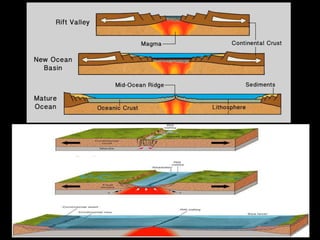Plate tectonics
- 1. Plate tectonics and Types of Plate boundaries DEPARTMENT OF GEOLOGY Guided By Presented By Prof. Lalsingh Solanki Aakash khede M.Sc. 1st semester
- 2. Table of contents 1. Introduction 2. Concept of Plate tectonics 3. What is Plate ? 4. What is Plate tectonics ? 5. What are Tectonic plates made up of ? 6. Types of plate boundaries 6.1 Divergence 6.2 Convergence 6.2.1 Ocean-Continent convergence 6.2.2 Ocean-Ocean convergence 6.2.3 Continent-Continent convergence 6.3 Transform 7. Plate movement 8. Physical features of Plate Tectonics 9. Importance of Plate Tectonics 10. References
- 3. INTRODUCTION The concept of plate tectonics was formulated in the 1960s. According to the theory, Earth has a rigid outer layer, known as the lithosphere, which is typically about 100 km (60 miles) thick and overlies a plastic (moldable, partially molten) layer called the asthenosphere. The lithosphere is broken up into seven very large continental- and ocean-sized plates, six or seven medium-sized regional plates, and several small ones. These plates move relative to each other, typically at rates of 5 to 10 cm (2 to 4 inches) per year, and interact along their boundaries, where they converge, diverge, or slip past one another. Such interactions are thought to be responsible for most of Earth’s seismic and volcanic activity, although earthquakes and volcanoes can occur in plate interiors. Plate motions cause mountains to rise where plates push together, or converge, and continents to fracture and oceans to form where plates pull apart, or diverge. The continents are embedded in the plates and drift passively with them, which over millions of years results in significant changes in Earth’s geography.
- 4. CONCEPT OF PLATE TECTONICS Plate tectonic theory is based on two major scientific concept : 1. The concept of continental drift :- In 1908 , It was F.B Taylor who propounded the continental – drift hypothesis , incorporating much other geological evidence . In 1910 and 1912 , Alfred Wegener , a German meteorologist , advocated the continental had drifted apart and suggested mechanism by which this might have occurred . 2. The concept of sea floor spreading:- Seafloor spreading is a process that occurs at mid-ocean ridges, where new oceanic crust is formed through volcanic activity and than gradually moves away from the ridge. Professor Harry Hess of Princeton university was first to formulate the hypothesis of ‘seafloor spreading; in 1960.
- 5. If you look at a map of the world , you may notice that some of the continental could fit together like pieces of a puzzle.
- 6. What is Plate ? • Plate term was first used by Canadian Geophysicist J. T. Wilson in 1965. • W. J. Morgan and Le Pichon elaborated the various aspects of plate tectonic in 1968. • A Plate is a large, rigid slab of rock which move slowly over the Asthenosphere. • The thickness of a plate is from ‘ 0 to 10 Kms at the ridges and 100 to 150 km elsewhere. • There are 6 major and 20 minor plates present on the world map. • The rigid lithospheric slabs or rigid and solid crustal layers are technically called plates. • The Earth’s crust and upper mantle are broken into sections called plates. • Plates move around on top of the mantle like rafts.
- 7. World Plates
- 8. What is plate tectonics ? The whole mechanism of the evolution, nature and motion of plates and resultant reaction is called plate tectonic. Or the whole process of plate motion is referred to as plate tectonic. Plate boundary- zone of motion between two plates. Plate margin- the marginal part of a particular plate.
- 9. Plate Tectonics 1. The earth’s crust Is divided into 7 major plates which are moved in various directions. 2. The Plates Collide, Pull apart or scrape against each other. 3. Each motion causes different types of features on the Earth’s crust. 4. The word tectonic refers to the changes in the crust because of plate interaction.
- 10. What are Tectonic Plates made up of ? • Plates are made of rigid lithosphere. • The lithosphere is made up of the upper part of the mantle. What lies beneath the tectonic Plates ? • Below the lithosphere is the asthenosphere.
- 13. Divergence Boundaries • Spreading ridges As plates moves apart magma fill up the gap.
- 14. Age of Ocean Crust Mid Atlantic ridge
- 16. Rift valley
- 18. Andes Mountain range in South America
- 20. Best Example of Continent-Continent convergence “The Himalayas“
- 22. • Mariana Trench is located in the Western Pacific Ocean about 200 km east of the Mariana Islands. Mariana Trench is 2,550 km long and 69 km wide.
- 27. Plate movement Plates of the lithosphere are moved around by the underlying hot mantle convection cells.
- 30. Importance of Plate-Tectonic theory • Origin and distribution of earthquakes. • Origin of mountain ranges and their distribution . • Formation of island arcs and oceanic trenches. • Distribution of volcanoes. • Continental drift. • Formation of mid-oceanic ridges and rift valleys. • Sea-floor spreading, etc.
- 31. References 1. DR. GHOSH MUKUL & DR. SHRIVASTAV D. K., PHYSICAL GEOLOGY, MADHYA PRADESH HINDI GRANTH ACADEMY BHOPAL ( page no. 113 to 133) 2. MAHAPATRA G.B. , THE TEXTBOOK OF PHYSICAL GEOLOGY,2014,CBS PUBLISHERS(page no. 128 to 172) 3. https://en.m.wikipeduia.org/wiki/Plate_tectonics 4. Youtube.com































